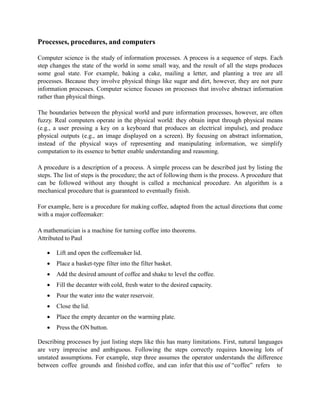
Processes, procedures, algorithms and computers
- 1. Processes, procedures, and computers Computer science is the study of information processes. A process is a sequence of steps. Each step changes the state of the world in some small way, and the result of all the steps produces some goal state. For example, baking a cake, mailing a letter, and planting a tree are all processes. Because they involve physical things like sugar and dirt, however, they are not pure information processes. Computer science focuses on processes that involve abstract information rather than physical things. The boundaries between the physical world and pure information processes, however, are often fuzzy. Real computers operate in the physical world: they obtain input through physical means (e.g., a user pressing a key on a keyboard that produces an electrical impulse), and produce physical outputs (e.g., an image displayed on a screen). By focusing on abstract information, instead of the physical ways of representing and manipulating information, we simplify computation to its essence to better enable understanding and reasoning. A procedure is a description of a process. A simple process can be described just by listing the steps. The list of steps is the procedure; the act of following them is the process. A procedure that can be followed without any thought is called a mechanical procedure. An algorithm is a mechanical procedure that is guaranteed to eventually finish. For example, here is a procedure for making coffee, adapted from the actual directions that come with a major coffeemaker: A mathematician is a machine for turning coffee into theorems. Attributed to Paul Lift and open the coffeemaker lid. Place a basket-type filter into the filter basket. Add the desired amount of coffee and shake to level the coffee. Fill the decanter with cold, fresh water to the desired capacity. Pour the water into the water reservoir. Close the lid. Place the empty decanter on the warming plate. Press the ON button. Describing processes by just listing steps like this has many limitations. First, natural languages are very imprecise and ambiguous. Following the steps correctly requires knowing lots of unstated assumptions. For example, step three assumes the operator understands the difference between coffee grounds and finished coffee, and can infer that this use of “coffee” refers to
- 2. coffee grounds since the end goal of this process is to make drinkable coffee. Other steps assume the coffeemaker is plugged in and sitting on a flat surface. One could, of course, add lots more details to our procedure and make the language more precise than this. Even when a lot of effort is put into writing precisely and clearly, however, natural languages such as English are inherently ambiguous. This is why the United States tax code is 4. million words long, but lawyers can still spend years arguing over what it really means. Another problem with this way of describing a procedure is that the size of the description is proportional to the number of steps in the process. This is fine for simple processes that can be executed by humans in a reasonable amount of time, but the processes we want to execute on computers involve trillions of steps. This means we need more efficient ways to describe them than just listing each step one-by-one. People have been developing procedures for thousands of years. For example, in Elements (300 BC), Euclid describes a procedure for computing the greatest common divisor of two numbers. The full procedure is not important to understand here, but what is relevant is how he described it: To program computers, we need tools that allow us to describe processes precisely and succinctly. Since the procedures are carried out by a machine, every step needs to be described; we cannot rely on the operator having “common sense” (for example, to know how to fill the coffeemaker with water without explaining that water comes from a faucet, and how to turn the faucet on). Instead, we need mechanical procedures that can be followed without any thinking. A computer is a machine that can: Accept input. Input could be entered by a human typing at a keyboard, received over a network, or provided automatically by sensors attached to the computer. Execute a mechanical procedure, that is, a procedure where each step can be executed without any thought. Produce output. Output could be data displayed to a human, but it could also be anything that affects the world outside the computer such as electrical signals that control how a device operates. A computer terminal is not some clunky old television with a typewriter in front of it. It is an interface where the mind and body can connect with the universe and move bits of it about. DouglasAdams Computers exist in a wide range of forms, and thousands of computers are hidden in devices we use every day but don’t think of as computers such as cars, phones, TVs, microwave ovens, and
- 3. access cards. Our primary focus is on universal computers, which are computers that can perform all possible mechanical computations on discrete inputs except for practical limits on space and time. The next section explains what it discrete inputs means; Chapters 6 and 12 explore more deeply what it means for a computer to be universal.